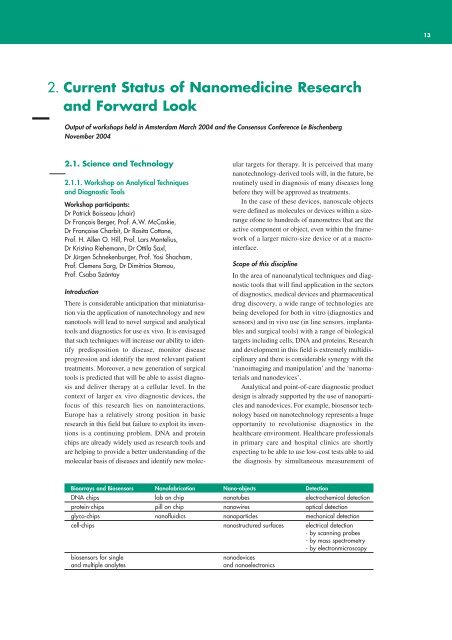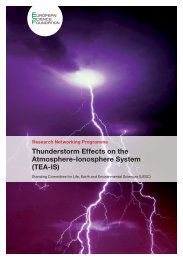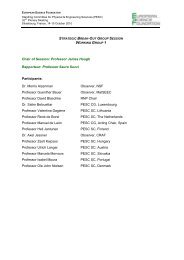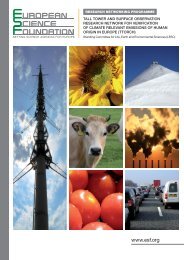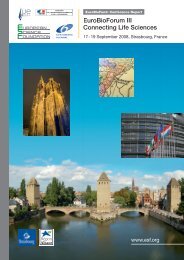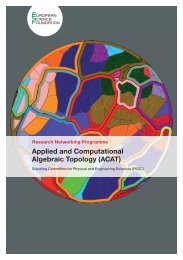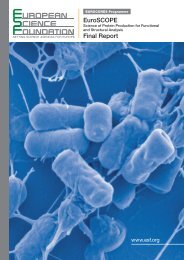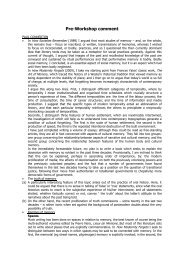Nanomedicine - European Science Foundation
Nanomedicine - European Science Foundation
Nanomedicine - European Science Foundation
Create successful ePaper yourself
Turn your PDF publications into a flip-book with our unique Google optimized e-Paper software.
13<br />
2. Current Status of <strong>Nanomedicine</strong> Research<br />
and Forward Look<br />
Output of workshops held in Amsterdam March 2004 and the Consensus Conference Le Bischenberg<br />
November 2004<br />
2.1. <strong>Science</strong> and Technology<br />
2.1.1. Workshop on Analytical Techniques<br />
and Diagnostic Tools<br />
Workshop participants:<br />
Dr Patrick Boisseau (chair)<br />
Dr François Berger, Prof. A.W. McCaskie,<br />
Dr Françoise Charbit, Dr Rosita Cottone,<br />
Prof. H. Allen O. Hill, Prof. Lars Montelius,<br />
Dr Kristina Riehemann, Dr Ottila Saxl,<br />
Dr Jürgen Schnekenburger, Prof. Yosi Shacham,<br />
Prof. Clemens Sorg, Dr Dimitrios Stamou,<br />
Prof. Csaba Szántay<br />
Introduction<br />
There is considerable anticipation that miniaturisation<br />
via the application of nanotechnology and new<br />
nanotools will lead to novel surgical and analytical<br />
tools and diagnostics for use ex vivo. It is envisaged<br />
that such techniques will increase our ability to identify<br />
predisposition to disease, monitor disease<br />
progression and identify the most relevant patient<br />
treatments. Moreover, a new generation of surgical<br />
tools is predicted that will be able to assist diagnosis<br />
and deliver therapy at a cellular level. In the<br />
context of larger ex vivo diagnostic devices, the<br />
focus of this research lies on nanointeractions.<br />
Europe has a relatively strong position in basic<br />
research in this field but failure to exploit its inventions<br />
is a continuing problem. DNA and protein<br />
chips are already widely used as research tools and<br />
are helping to provide a better understanding of the<br />
molecular basis of diseases and identify new molecular<br />
targets for therapy. It is perceived that many<br />
nanotechnology-derived tools will, in the future, be<br />
routinely used in diagnosis of many diseases long<br />
before they will be approved as treatments.<br />
In the case of these devices, nanoscale objects<br />
were defined as molecules or devices within a sizerange<br />
ofone to hundreds of nanometres that are the<br />
active component or object, even within the framework<br />
of a larger micro-size device or at a macrointerface.<br />
Scope of this discipline<br />
In the area of nanoanalytical techniques and diagnostic<br />
tools that will find application in the sectors<br />
of diagnostics, medical devices and pharmaceutical<br />
drug discovery, a wide range of technologies are<br />
being developed for both in vitro (diagnostics and<br />
sensors) and in vivo use (in line sensors, implantables<br />
and surgical tools) with a range of biological<br />
targets including cells, DNA and proteins. Research<br />
and development in this field is extremely multidisciplinary<br />
and there is considerable synergy with the<br />
‘nanoimaging and manipulation’ and the ‘nanomaterials<br />
and nanodevices’.<br />
Analytical and point-of-care diagnostic product<br />
design is already supported by the use of nanoparticles<br />
and nanodevices. For example, biosensor technology<br />
based on nanotechnology represents a huge<br />
opportunity to revolutionise diagnostics in the<br />
healthcare environment. Healthcare professionals<br />
in primary care and hospital clinics are shortly<br />
expecting to be able to use low-cost tests able to aid<br />
the diagnosis by simultaneous measurement of<br />
Bioarrays and Biosensors Nanofabrication Nano-objects Detection<br />
DNA chips lab on chip nanotubes electrochemical detection<br />
protein-chips pill on chip nanowires optical detection<br />
glyco-chips nanofluidics nanoparticles mechanical detection<br />
cell-chips nanostructured surfaces electrical detection<br />
- by scanning probes<br />
- by mass spectrometry<br />
- by electronmicroscopy<br />
biosensors for single<br />
nanodevices<br />
and multiple analytes<br />
and nanoelectronics


